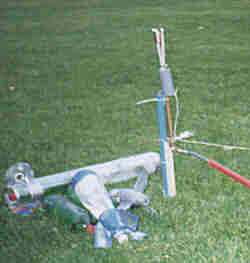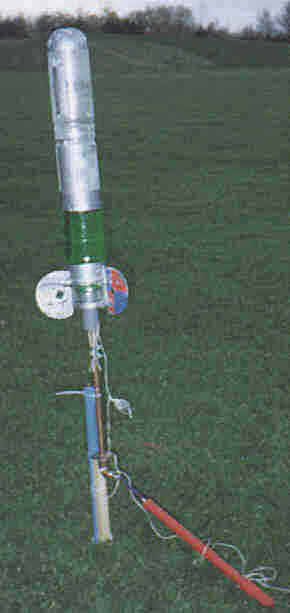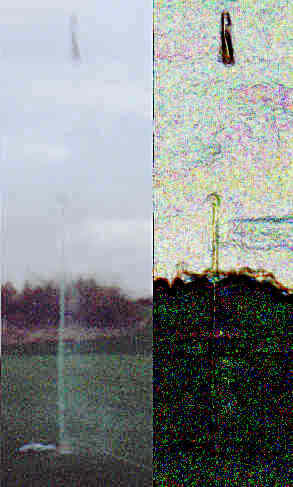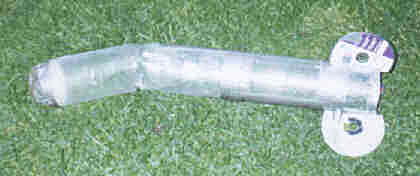|
|
Lift off 2 x 2
litre
These
are photographs taken of the first launches
of the 2 x 2 litre rocket which flew to
around 250 feet.
 Typical set of
rockets for a day's launching. The 1 litre and
1½ litre 'Egglofters' together with the 2 x 2
litre rocket and a bottle of water with food
colouring in it. Typical set of
rockets for a day's launching. The 1 litre and
1½ litre 'Egglofters' together with the 2 x 2
litre rocket and a bottle of water with food
colouring in it. Off to the right of the
launcher, the release string extends for a
further 20 metres or so along firm ground so that
the person who pumps up the pressure (me)
does not slip in the mud if he has to hurry back
for some reason.
The 2 x 2 litre and the 1½ litre 'Egglofter'
are both already filled and have been take to the
launch site with tops on. Doing this gives an
extra launch per rocket.
|
 This is it. All
ready to go, sitting with 1.6 litres of water in
the lower bottle. This is it. All
ready to go, sitting with 1.6 litres of water in
the lower bottle.Note that the plastic sleeve
on the launcher fits up, inside the skirt of the
rocket with plenty of clearance. This launcher,
even with its temporary mounting on a swingball
base, can take rockets with skirts upto a foot
long.
Also visible in this picture is the bulge in
the gaffer tape on the left CD ROM where the
loose end of the cable tie goes. This helps to
keep the fin in a reasonable position. Note that
the cable ties fit around the skirt in a place
that is not in direct contact with the
pressurised bottle.
In addition to this, the waist in the middle,
supporting section can be seen and the fact that
the upper bottle is not taped in place. By
keeping the upper bottle free in this way, it may
be replaced if it becomes unacceptably damaged.
|
 This is a
photograph of the 2 x 2 litre rocket that has
been enhanced with edge detection again. This is a
photograph of the 2 x 2 litre rocket that has
been enhanced with edge detection again. On
the left, the green dyed spray is clearly visible
although, again, the rocket is blurred because of
the combined movement of the rocket and the
camera.
On the right, the edge detect has picked up
the shape of the spray above the level of the
horizon and shows that the compressed air from
the rocket has blown back the very top of the
column of water to form the cone shape that is
visible.
To the great amusement of the people playing
football on the adjacent fields, the ground
crew counted down at the tops of
their voices bofore the rocket went off.
The rocket stayed in the air for around 9
seconds - taking 5 seconds to get from apogee
back to earth
|
 When it did get
back to earth, it did so at quite a speed. When it did get
back to earth, it did so at quite a speed.If
this sort of damage is too great (this one
survived a pressure test and went on to perform
many more launches and has only recently been
retired - I needed the parts for something else) then
the top bottle can simply be unscrewed and
replaced
Next project on the list is a recovery system.
|
 Back to the Rocket Design Back to the Rocket Design
 Back to the Water Rocket Index Back to the Water Rocket Index
|
|